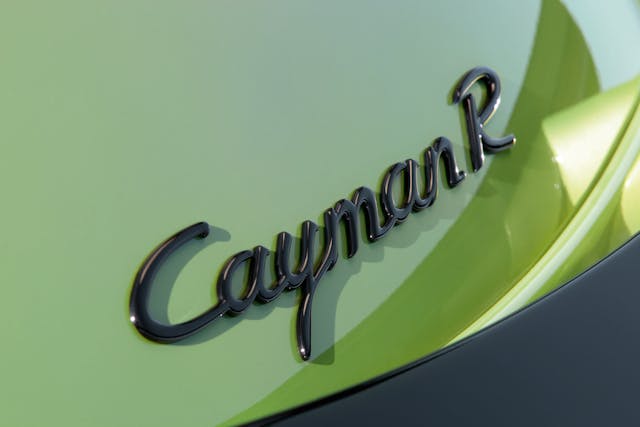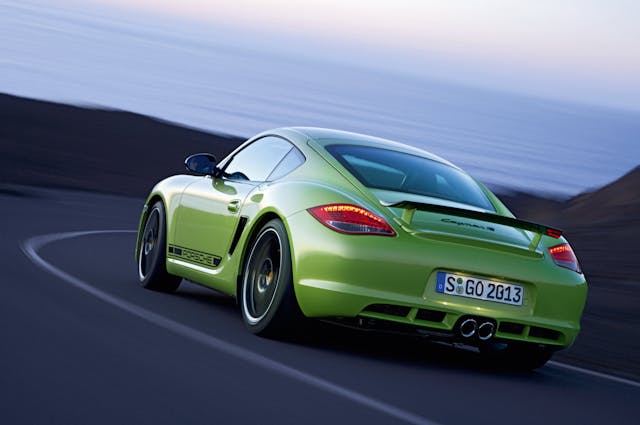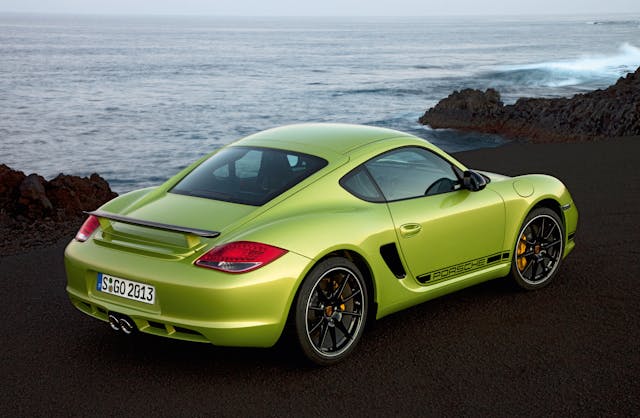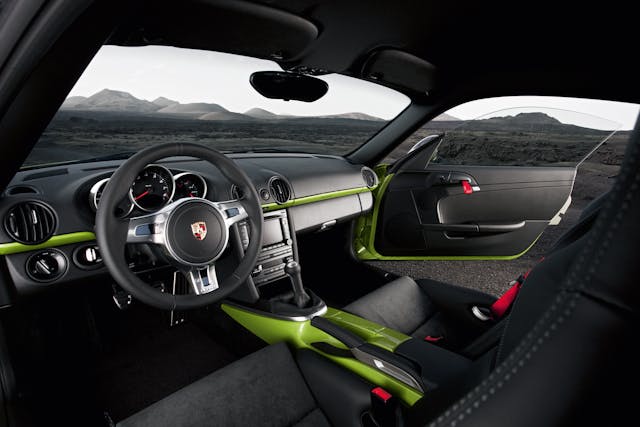Porsche Cayman R: How To Have Your Cake and Eat It, Too
This is a story about the track-ready Porsche Cayman R, which we’ll get to in just a moment, but let’s spend a minute talking about how the Cayman came to be.
It did not take a financial analyst to discover that Porsche, circa 1992, was having issues. The 911 was selling passably well—it almost always finds its audience—but the pricey 928 was failing to win the hearts and minds, not to mention to pocketbooks, of the Porsche faithful, especially near the end of its run, which finally occurred in 1995.
Similarly, the 968, introduced in 1991 as a replacement for the 944, wasn’t being embraced by sports car fans looking for an entry point into the Porsche brand. Though the company insisted that 80 percent of the 968 was new, it perhaps wasn’t different enough from the 944 to ignite a fire among potential customers. By the time it was dropped from the lineup in 1995, it was quite a good car, but it just wasn’t selling.
Meanwhile, Porsche executives were rethinking the whole entry-level-model conundrum. They arrived at something that felt comfortable—the Boxster concept car, which debuted at Detroit’s North American International Auto Show in 1993. “We had originally planned to present our concept car in Geneva in spring 1993,” says Grant Larson, lead designer of the car. “But we decided on Detroit in January because we did not want to waste any time.”
The mid-engine roadster was an unqualified hit. When the production car hit the market in 1996, it was very faithful to that concept. Twenty-five years later, total Boxster sales had topped 350,000.
But not everyone wants a roadster, those Porsche executives reasoned. (Especially Porsche fans, it turns out—coupe models are consistently valued higher than their drop-top stablemates within this brand.) What if they took the Boxster platform and made a coupe? Versatile designer Pinky Lai, who joined Porsche after styling the BMW E36, was assigned to the car. Yes, it was influenced by the 911, but it was different enough not to tread on its territory. Thus was born the Cayman, which debuted as a 2006 model.
The base Cayman was powered by a 2.7-liter six-cylinder engine, while the Cayman S got a 3.4-liter engine. But Porsche thought there was room for a more performance-oriented Cayman, which finally came in 2011: That was the Cayman R. But after 2012, it was gone, with the pending arrival of the third-generation Cayman.



A nice little niche market remains for the 1621 Cayman R models that Porsche cranked out. It isn’t that much more powerful than the Cayman S and Boxster Spyder—just an additional 10 horsepower from the 3.4-liter six-cylinder, achieved by tweaking the exhaust system.
But it’s what surrounds that 330-horsepower engine that gives the Cayman R its track credibility. Taking a page from the Lotus playbook, Porsche designers and engineers put the Cayman R on a diet, not that the Cayman S was all that porky. They managed to trim as much as 121 pounds, starting with aluminum doors, lighter seats, different (19-inch) wheels and a fixed rear wing. Fabric straps replaced interior door pulls.


Additional pounds were shed by those willing to, as Porsche put it, “Do without convenience equipment.” That included air conditioning and a sound system, which is good for a 33-pound savings. (Thankfully, you could add those two back in if you valued being cool and entertained.) After that, it got expensive. A lighter lithium-ion battery could save 26 pounds but would cost you $1700. Carbon-ceramic brakes cut seven pounds, at a cost of $8150.
The standard transmission was a six-speed manual, but you could swap that out with a seven-speed PDK automatic, though it weighed an extra 55 pounds.

Fortunately, there were other changes. “With its specially adapted sports chassis,” Porsche said, “it provides an even more precise driving experience than the Cayman S.” Improved aerodynamics substantially reduced front and rear lift. The addition of the Sport Chrono package whacked three-tenths of a second off the 0 to 60 mph time, trimming it to about 4.5 seconds. Top speed was 175 mph with the manual transmission, 174 with the PDK automatic.
While all these adjustments made for a potent track rat, the R was as accommodating on the road as any Cayman model. As thin and lightweight as those seat were, they weren’t nearly the punishment you’d expect them to be.



There remains a strong market for the Cayman R, which was introduced at a base price of $67,250. Hagerty values a Cayman R in #2 (“excellent”) condition at $90,300, and a #3 (“good”) example at $74,000. By comparison, a 2012 Porsche Cayman S in #3 condition is valued at $40,000.
Values started increasing during 2019 and through the pandemic boom, but have been largely flat for the last two years. From the beginning of 2018 to the end of 2022, condition #2 values for the Cayman R grew 54 percent, which was a higher percentage than any other version of 2006-12 Cayman. They haven’t moved at all since the end of 2022.
Buyer interest for all 2006-12 Caymans pretty much mirrors the classic car market as a whole. Baby boomers make up 36 percent of Cayman policyholders that Hagerty covers, with members of Generation X representing 33 percent. Millennials appreciate the Cayman, too, making up nearly 20 percent of policies.

Bringatrailer.com has sold at least four Cayman Rs in the past year or so: Two for $75,000 each, one for $74,500, and one for $68,250. As of Wednesday afternoon, two Cayman Rs are presently being offered on the site.
As with any performance car, a Cayman R that has been consistently beat on during track days is likely to need more work than the proverbial, school-teacher-just-driven-to-church-on-Sunday car. Though many of these cars have led a coddled life, plenty did get used as intended, so be sure to shop for your particular use case.
And we don’t know about you, but we like our air conditioning and sound systems.

***
Check out the Hagerty Media homepage so you don’t miss a single story, or better yet, bookmark it. To get our best stories delivered right to your inbox, subscribe to our newsletters.



Even looking at total 987 Cayman production from 2006-12, there were far fewer built than the corresponding 997 911s. With many .1 S models being parted out or turned into race cars after suffering engine failures, the number of survivors continues to shrink. I think these cars will only become more desirable with time.
As the owner of a “Peridot” Metallic Green the LAUNCH color (as pictured in this article) 2012 Cayman R with 4 digits mileage, I can agree with the author about everything is said
here and more !
These cars are truly very unique and special in many ways .
The Cayman R was the very first Porsche that was given the
prestigious letter ‘R’ after the original 911R of the late ’60’s that arguably concedered by many around the world, the holy grail of
all 911s .
In my opinion, a Cayman R is not designed or intended to be an outright race car, but a very finely factory tuned precision driving machine, with the same intentions by the Porsche
engineers who introduced the mighty 2016 911R .
The 2012 Boxsters and Caymans were the last to still have the wonderful hydraulic power steering and had just the right amount of electronically controlled creature comforts and, a real HAND BRAKE .
Cayman’s are fun cars. I always preferred them over the Boxster as I really am not into cloth top convertibles. I would rather have the stuff left out that saved a whopping 33 lbs. You will not notice 33 pounds lost in that car.
“When the production (Boxster) hit the market in 1996, it was very faithful to that concept.”
My guess is Mr. Larson would disagree; I know I do.
The Boxster Concept’s rising rear haunches with architectural “fins” housing the tail lights at their trailing edge, rear brake cooling scoops low down on the rockers, and sculpted body sides rendered a car that was much more muscular, aggressive, and purposeful looking than the eventual production model.
While a wonderful driver’s car, the production car had nowhere near the presence of the concept.
I presently have a 2014 white Boxster 2.7 small block V6 with the lovable PDK transmission 7-speed. I fell instantly in love, I’ve had it going on a year mark. I’m fully aware it’s the entry level Porsche, but if you won’t tell 😉, I won’t either. I love the way it handles, in my opinion, it’s quicker than it is fast, if that makes any sense. Nevertheless, if I had to do it all over again, only thing I’d do different is get the “S” model. However, I’ll take great care of my little investment until it comes time to set my eyes on a Cayman or perhaps the 911. God willing, and if the sun & moon are in the right orbit, just maybe. All my friends would ask ” man why I Porsche & not a Corvette”? My response, ” Corvette’s are a dime a dozen & overrated in my opinion, besides, I didn’t want to enter the rat race”. By grabbing a Porsche, it’s very unique, and in my area, they have a certain level of mystique as well.
The Boxster/Cayman and 911 have ‘boxer’ engines, flat sixes, not v sixes.
My first Porsche was a 2007 Cayman, and now I have a 2012 Cayman R manual. All I can say is people don’t really understand how underrated this car really is.
Wait, what? The 987.1 Cayman S has 295 hp per the owners manual and just about every other source out there. I can’t say how much hp the R has but 330-assuming the author got that correct-is 35hp more than the S and enough to make a noticeable difference even for a non-enthusiast.
The Cayman S got 320hp as standard for the 2009-12 refresh, so the R is 10hp more.